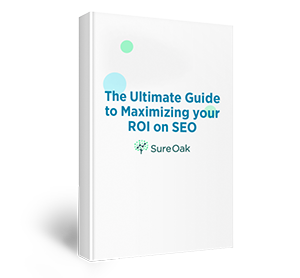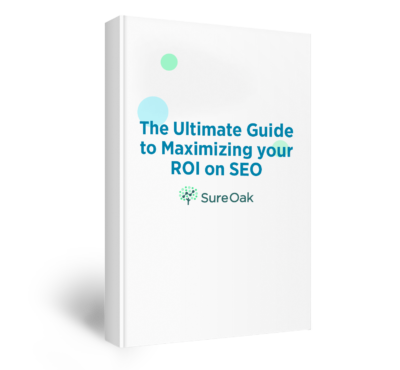SEO and CRO focus on different aspects of users interacting with a website. The goal of SEO is to generate visibility and drive traffic to a website, while the goal of CRO is to optimize the conversion pathways users can take once they’re on a website.
Most companies place a strong emphasis on either search engine optimization (SEO) or conversion rate optimization (CRO), but it’s important that these two strategies work together.
By understanding how to combine SEO and CRO efforts, you’ll improve user engagement on your website, and that often translates into new business.
What is SEO?
SEO is the acronym for Search Engine Optimization. The term describes the method of increasing organic traffic to your website by generating visibility on search engine results page (SERP). To truly understand SEO, you need to understand that the goal of a search engine is to deliver the highest quality results in response to users’ search queries.
Results are made up of pages. And while there is a myriad of search ranking factors that affect an individual page’s ability to rank for specific keywords, search engines also take into consideration the page’s domain in order to determine whether or not a page is worthy of ranking for a particular keyword phrase. In other words, a page’s ability to rank isn’t solely based on its merit; it’s based on the merit of the entire website as well.
Businesses that value SEO as a part of their digital marketing efforts have the ambition to increase visibility by ranking for as many relevant keywords as possible. And in doing so, to draw in more qualified traffic and potential customers to their websites. The idea is, the more users you draw in, the more likely you are to make a sale. After all, you can’t make a sale if no one can find you online. The following are a few common SEO strategies.
Page Optimization
On-page SEO is the key to optimizing individual web pages in an attempt to gain more traffic, specifically from search engines. A couple of on-page elements that can be optimized include the title and the URL. While both those elements play an important role for the reader and user experience, they also help search engines crawl, or read, and understand your pages.
How does optimizing specific elements help search engines better understand your pages?
Let’s look at the title as an example. The title — more or less — boils down a page’s topic into 50–60 characters. It’s displayed on search engine results pages (SERPs) in the form of a clickable headline. Including phrases, or keywords, that are as close to an exact match as possible to users’ search queries will help your page outrank competing pages.
But the title tag can also make or break whether a visitor clicks through to your site. It should, in a way, provide an exact description of what users are hoping to see when they type in a search query. And, because you’re competing against other pages that are targeting the same users and have similar titles, your title shouldn’t just be descriptive; it should also be enticing.
Another important factor in page optimization is the URL.
The URL helps search engines understand the hierarchy of pages on a website, which helps them determine which pages are the most important. The URL for your homepage, for example, is often perceived as the most important URL, as it’s at the top of your domain’s hierarchy.
But the URL should also help search engines understand the page topic. Take the URL of this page, for example: https://www.sureoak.com/insights/how-seo-cro-complement-each-other
The inclusion of the words, “how,” “seo,” “cro,” and “complement” in the URL help search engines understand what this page is about. And, the fact the end of the slug — the /how-seo-cro-complement-each-other part of the URL — is preceded by a subfolder — i.e. /insights/ — helps search engines understand this page is lower within the site’s hierarchy.
These elements — the title, the URL, etc. — act as breadcrumbs that help search engines piece together the purpose of your pages so they can decide if they’re worthy of ranking, or not.
Link Building
Link building is considered an off-page SEO strategy. The idea is to earn links — ideally from high-quality websites — to your website. Those links are known as backlinks.
Backlinks are tied closely to your website’s domain authority (DA), a score provided by Moz that measures a website’s rapport with search engines. Generally, more links correlate to a higher DA, and a higher DA theoretically helps your pages rank for more difficult keyword phrases.
This is because search engines equate backlinks with authority — i.e. search engines use backlinks to measure your website’s overall authority, and authority is valuable.
Think of it like looking for a good restaurant. Would you rather go to a restaurant a lot of people recommend or a restaurant very few people recommend — or even bother to mention?
Content Creation
One of the most crucial aspects of SEO is content. To quote the 1996 Bill Gates adage that has seeped into SEO, across the web, and embedded into content creators: “content is king.” To gain worthy positions in SERPs, you must provide valuable and unique content. After all, that’s what the visitor is coming to your page for — to seek content relevant to their query.
But what makes content good?
Good content is compelling, comprehensive, unique, and ultimately it satisfies searchers’ intent. Good content is well written, highly organized, and easy to read. Good content targets a specific topic, explores it fully and keeps users engaged from the top to the bottom of the page.
Another aspect of good SEO content is linkability.
One way to create linkable content is to focus on extremely niche topics targeted at specific audiences. Another way is to approach a broad topic and cover it extremely comprehensively — i.e. create a comprehensive guide. A page that provides extreme value, such as exclusive research or a newsworthy story, can also make for a very linkable piece of content.
What is CRO?
CRO is the acronym for conversion rate optimization. If SEO is how you get users to your website, CRO is how you get users to take a desired action on your website.
Every website has different conversion goals. In fact, most websites have several conversion goals that vary across pages, depending on where users are in the sales funnel.
Conversions are broken into two categories: macro conversions, and micro conversions.
Macro conversions are large goals.
These conversions include:
- Purchasing a product.
- Requesting a quote for service.
- Subscribing to an ongoing service.
Micro conversions often occur prior to macro conversions.
Examples of micro conversions include:
- Signing up for an email list.
- Creating an online account.
- Putting a product in the shopping cart.
For both micro conversions and macro conversions, the method by which users take action is known as a call to action (CTA). A call to action can be a button, such as an “add to cart” button, a clickable phone number, or even a form that users fill out and submit.
There are several different types of CTAs, and each type is better suited for specific actions — a button is a tried-and-true method for adding items to an online shopping cart, for example.
And while CTAs may be the most important behavior to track
And while CTAs may be the biggest indicator of whether or not your website is driving user engagement, it’s not the only one. There are other, smaller indicators of whether or not users are engaged. Collectively, these indicators, including CTAs, are a measurement of your website’s user experience (UX), which is heavily influenced by its user interface (UI).
Fortunately, there are UX and UI best practices, and there are ways — in addition to CTAs — to track and measure the quality of the UX and the UI on your website.
User Interface (UI) and User Experience (UX)
Your website’s UI is comprised of the tangibles users interact with. Your website should have a simple and effective interface that allows users to easily navigate it with minimal searching or input — i.e. the user should be able to achieve their goals without having to work too hard.
Your website’s UX is a reflection of users’ reactions when they visit and spend time on it. In other words, the UX is users’ collective perception of your website. That perception is based on factors like ease of use, efficiency, and utility. UX is highly subjective and often changes easily based on preferences, preconceptions, learned behaviors, and even emotions.
When it comes to conversion rate optimization, UI and UX are equally important.
The UX component focuses on usability, adaptability, and functionality — i.e. creating an enjoyable experience. The UI component, on the other hand, aims to provide a responsive, intuitive, and easy-to-navigate interface that offers a high-quality look and feel.
When these criteria are met, users are more likely to take action, which increases conversions.
Sales Funnel
Your website’s sales funnel works like any other sales funnel, with the end goal being to convert users. But the process of turning a user into a conversion is often a multi-step process; it’s extremely uncommon for new users to land on your site and immediately take action.
They must be guided down the sales funnel.
Think of it like this: the width of a funnel gradually decreases from top to bottom, and that decrease represents the number of users who actually make it to the bottom and convert.
While there are many interpretations of the sales funnel — some of which include several different steps or stages — the most basic interpretation includes three steps:
- Awareness (top of the funnel): Users are simply researching a product or service you offer, comparing specifications and prices across different competitors.
- Consideration (middle of the funnel): Users have narrowed down their options and possibly even expressed interest — e.g. added an item to their cart.
- Decision (bottom of the funnel): Users are finalizing their decision, and are doing their last-minute due diligence to make sure they’re making the right choice.
To increase CRO, you must implement a marketing strategy that engages users in each stage of the buyer’s journey. Otherwise, you may lose them in the middle, or even worse, the bottom.
A/B Testing
Split testing or A/B testing refers to the process of literally testing different versions of a page — or specific elements of a page — on your website. Essentially, users are randomly sent to the various versions of the same page from search engine results pages in order to help marketers determine which version of the page is better, based on how users interact with them.
So, what specifically does A/B testing accomplish?
Here are a few of the many benefits:
- Learn users’ initial impressions of your website.
- Better understand what users are most interested in.
- Find out how users prefer to navigate your website.
- Pinpoint UI issues that are causing visitors to leave.
- Reduce bounce rates, which can impact search rankings.
And, last but not least, improve conversion rates.
However, despite the many benefits of A/B testing, you shouldn’t ever make changes to your website based on a gut feeling, no matter how minor they may seem. All changes should be supported by user testing. Otherwise, you could end up hurting your conversions.
CRO vs SEO: What’s the Difference?
While SEO and CRO are both important aspects of a comprehensive digital marketing effort, they serve very different purposes. SEO seeks to improve the visibility your website receives in search engines while CRO focuses on improving conversions from website visitors.
Think of one as before users land on your site and the other as after users land on your site. SEO benefits you before the user makes it to your site. Paid ads and search engine optimization help users find your website, allowing them to enter the sales funnel you have set up.
CRO comes into play after users visit your site. The primary goal is to get users to take action once they’re on your site in order to generate more leads and/or sales. And, ideally, users enjoy the experience so much that they return to your site.
While these two tactics serve two completely different purposes, they must be utilized together in order to get the most out of your website. Your strategy should not be considering CRO vs SEO, but working to find solutions that include both SEO and CRO.
The Importance of Combining SEO and CRO to Drive Engagement
If you focus solely on SEO or CRO, you are missing out. With SEO, you may get visitors to your site, but without dedicating time and effort to CRO, it’s unlikely they’ll take action. And in order to take advantage of a great sales funnel, you need to get users to your site from SERPs.
Optimizing for search and not conversions — and vice versa — can take a toll on your business and hinder your ability to meet your goals. You have to align your SEO and CRO efforts to ensure they’re working together to create the best user experience and drive engagement.
Let’s look at an example to highlight the symbiotic relationship between SEO and CRO.
The following example is focused on content:
When you’re creating content for SEO, you must focus on matching the search intent of users. In order to do that, you’ll need to perform keyword research to find out what users are most interested in, and then use that research to guide the topics you choose to write about.
Once you get users on your site, you want to get your products or services in front of them — regardless of which page they land on from SERPs. From there, you need to get them to convert using a combination of CTAs that all serve a distinct purpose within your sales funnel.
Great content — without an end goal — will simply not produce results.
Let’s look at Amazon as a more fine-tuned example of SEO and CRO working together. After all, they are a leader in online sales. So what makes you purchase something from Amazon?
For starters, the content on product pages isn’t limited to specifications; there are also FAQs. Not only that, but nearly every product includes detailed photos and sometimes videos. On top of all that, you can quickly read customer reviews from others who have made a purchase.
You even know exactly what to expect when it comes to shipping rates and delivery times.
In other words, there’s no guesswork involved, which is a big reason Amazon is the go-to online shopping retailer. And your goal should be to deliver an experience on that same level.
Why Work With the Same Agency for SEO and CRO Services?
When it comes to CRO and SEO in marketing, you don’t want more than one cook in the kitchen. That simply leads to confusion and chaos and can hinder your goals. Instead, you should find a dedicated team that you can trust to take on both your SEO and CRO efforts.
While your SEO strategy and CRO strategy will have individual tactics and efforts, they should not be solitary or exclusive of one another. They need to work symbiotically to create the best experience and draw your audience down your sales funnel.
By working with an experienced agency that understands SEO and CRO — and how they benefit each other — you can count on a united strategy, as well as streamlined communication. You also don’t have to worry about playing the middle man between two different agencies.
Additionally, hitting deadlines is much easier, as you don’t have to coordinate with two teams.
With a one-on-one relationship, you can navigate the challenges of SEO and CRO together.
What Makes Sure Oak the Ultimate SEO and CRO Partner
Selecting an agency to partner with for SEO and CRO services can be tricky. There are plenty of options out there, and it can be tough to find the perfect fit.
But when it comes to SEO and CRO, you need to work with an agency that understands the value of both, and that has the expertise to successfully execute both SEO and CRO strategies alongside one another to not only increase traffic but also increase conversions.
Our team at Sure Oak understands the value of leveraging SEO and CRO in tandem. We know that SEO is only one part of a comprehensive digital marketing program and that getting users to engage with your website is just as important as getting them there in the first place.
And when it comes to results, that’s our specialty. We are transparent with all our clients about the value of their marketing spend. We consistently review detailed and up-to-date reports with all of our clients in order to determine the best course of action moving forward — whether that is to simply stay the course or consider making adjustments to the current strategy.
We’re completely dedicated to your success and the success of all our clients. When you meet your goals, it’s a personal victory for us. But it’s also a victory for our partnership.
To learn more about our service options, check out our SEO Game Plan — a great starting point for most businesses, especially first-time forayers into SEO. We also offer ongoing on-page SEO services and conversion rate optimization services. Whatever struggles and hurdles are in front of you, we can help you overcome them. Book a free strategy session today.









